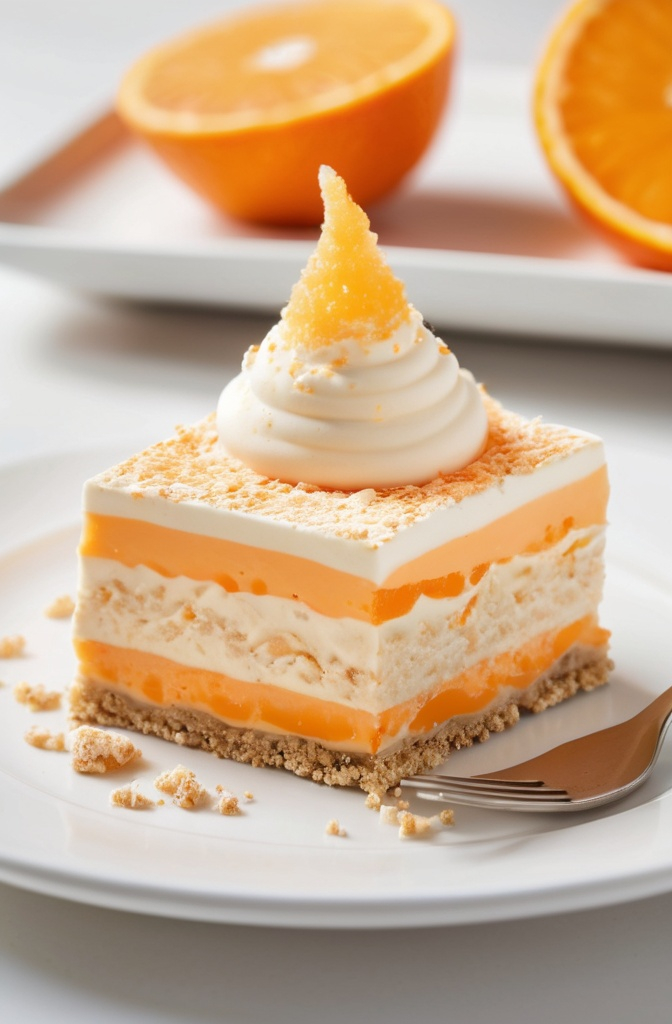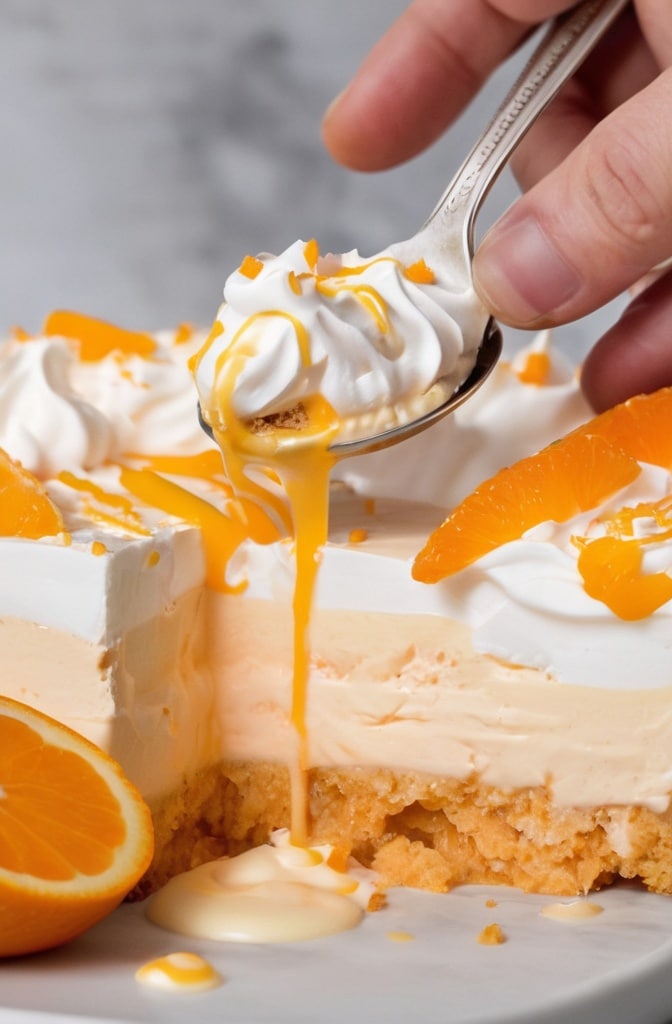The first time I made this No Bake Orange Creamsicle Delight, it was during a sweltering July heatwave when turning on the oven felt like a personal betrayal. My kitchen thermometer read 91°F, and I had promised dessert for a dinner party happening in just three hours. Desperation, as they say, breeds innovation. What emerged from that sweaty afternoon wasn’t just a cooling dessert it was a No Bake Orange Creamsicle Delight epiphany in texture and flavor balance that’s graced countless summer gatherings since.
Ever notice how certain flavor combinations instantly transport you back to childhood? That magical marriage of vanilla and orange does exactly that. This no-bake wonder captures the nostalgic essence of those orange and vanilla popsicles we’d chase down the ice cream truck for, but elevates it to something sophisticated enough for even the most discerning adult palates.
This recipe isn’t merely convenient because it dodges the oven it’s brilliant because the absence of heat allows the citrus notes to remain bright and the creamy elements to maintain there delicate texture. Let me show you why professional chefs keep versions of this dessert in their summer repertoire.
Ingredients & Substitutions
For the Crust
- 2 cups graham cracker crumbs (about 14 full sheets)
- 1/2 cup unsalted butter, melted
- 1/3 cup granulated sugar
- 1/4 teaspoon fine sea salt
For the Filling
- 16 ounces cream cheese, softened (2 standard blocks)
- 1 cup heavy whipping cream
- 3/4 cup granulated sugar
- 1 tablespoon orange zest (from approximately 2 medium oranges)
- 1/3 cup fresh-squeezed orange juice
- 2 tablespoons orange liqueur (Grand Marnier or Cointreau) – optional
- 2 teaspoons vanilla bean paste (or pure extract)
- 1 envelope unflavored gelatin (about 2 1/4 teaspoons)
- 3 tablespoons cold water
- Orange food coloring (optional, but adds visual appeal)
For the Topping
- 1 cup heavy cream
- 3 tablespoons powdered sugar
- 1 teaspoon vanilla extract
- Orange segments for garnish
- Additional orange zest for garnish
The foundation of any exceptional dessert lies in ingredient quality. For the orange component, Valencia or Cara Cara oranges offer superior flavor complexity compared to standard navels. Their higher acid-to-sugar ratio creates that distinctive “creamsicle” tang we’re after. If creamsicles aren’t your childhood reference point, think of the filling as a sophisticated orange cheesecake mousse with vanilla undertones.
For dairy-free adaptations, coconut cream works surprisingly well in place of heavy cream, while dairy-free cream cheese alternatives have improved dramatically in recent years. Mascarpone can replace standard cream cheese for a more luxurious mouthfeel, tho the filling will be slightly softer.
Graham crackers can be swapped for gingersnaps or vanilla wafers—each bringing its own character to the foundation. I’ve even used crushed shortbread with excellent results when seeking a more buttery base.
Step-by-Step Instructions

Preparing the Crust
- Combine graham cracker crumbs, melted butter, sugar, and salt in a medium bowl, mixing until the texture resembles wet sand. The mixture should hold together when pressed between your fingers—if it seems dry, add another tablespoon of melted butter.
- Press the mixture firmly into the bottom of a 9-inch springform pan, using the bottom of a measuring cup to compact it evenly. Don’t rush this step; a properly compacted crust prevents crumbling when serving.
- Refrigerate the crust for at least 30 minutes to set while you prepare the filling. For deeper flavor development, toast the graham crumbs in a dry skillet before mixing with butter—this extra step creates nutty undertones that complement the orange beautifully.
Creating the Filling
- In a small bowl, sprinkle gelatin over cold water and let stand for 5 minutes until bloomed. Once bloomed, heat the mixture in the microwave for 10-15 seconds until just melted, or place the bowl in a small saucepan of simmering water. Be careful not to boil the gelatin as excessive heat destroys its setting properties.
- Beat the softened cream cheese and sugar in a large bowl until smooth and fluffy, about 2-3 minutes. A common mistake is undermixing here—you want absolutely no lumps, as they’re impossible to remove later. Stop and scrape down the bowl frequently.
- Gradually beat in the orange juice, zest, liqueur (if using), and vanilla bean paste until fully incorporated. The mixture might look slightly curdled due to the acidic orange juice—this is normal and will smooth out as you continue.
- With the mixer running on low, slowly pour in the melted gelatin mixture, ensuring it’s fully integrated. Add a few drops of orange food coloring if desired, just enough to give a gentle sunset hue.
- In a separate bowl, whip the heavy cream to stiff peaks. Be careful not to overwhip, which turns cream grainy. You’ll know it’s perfect when the whisk leaves distinct trails that hold their shape.
- Using a spatula, gently fold the whipped cream into the cream cheese mixture in three additions. The folding technique is crucial: cut through the center, sweep along the bottom, and fold over the top. Rotate the bowl as you go. This preserves the air bubbles that create the mousse-like texture.
- Pour the filling over the chilled crust, smoothing the top with an offset spatula. Tap the pan gently on the counter a few times to release any large air bubbles.
- Refrigerate for at least 4 hours, but preferably overnight. Patience yields structural integrity—rushing will result in a filling that’s too soft to slice cleanly.
Finishing Touches
- When ready to serve, whip the cream for the topping with powdered sugar and vanilla until soft peaks form. Unlike the filling, the topping looks best with slightly softer peaks for a more billowy appearance.
- Spread or pipe the whipped cream over the set filling. I prefer piping rosettes around the perimeter for special occasions—it gives a professional finish with minimal effort.
- Garnish with fresh orange segments and a light sprinkling of orange zest. For maximum visual impact, supremed orange segments (with membrane removed) create an elegant presentation. A tiny mint leaf or two provides a welcome color contrast.
The dessert can be made up to two days in advance and kept refrigerated. Just add the whipped cream topping and garnishes shortly before serving for the freshest appearance.
Cooking Techniques & Science
While traditional creamsicle flavors typically rely on artificial ingredients, our version harnesses natural flavor compounds through strategic technique. The combination of fresh zest and juice provides a layered citrus experience—the oils in the zest contain terpenes that offer aromatic complexity, while the juice contributes both acidity and sweetness.
The gelatin in this recipe serves a critical structural role. Unlike baked cheesecakes that rely on eggs for setting, our no-bake version depends on gelatin’s unique properties. When gelatin blooms (hydrates) and then melts, its protein strands unwind. As the mixture cools, these strands reconnect to form a three-dimensional matrix that traps water molecules, creating a stable gel.

The beating process for the cream cheese isn’t merely about smoothness—it’s about incorporating air. Those tiny air bubbles, when stabilized by fat molecules, create the light yet rich texture that makes this dessert so compelling. It’s the same principle that makes whipped cream magical, just applied to a denser medium.
For those interested in molecular gastronomy adaptations, agar-agar can replace gelatin (use about 1 teaspoon) for a firmer set and vegetarian-friendly version. The texture will be slightly different—more clean-breaking than creamy-melting—but still delicious.
Temperature management is essential throughout this recipe. All ingredients should be at proper temperatures before beginning: cream cheese at room temperature for smooth blending, cream cold from the refrigerator for optimal whipping, and gelatin neither too hot nor cold when incorporated. These small details make the difference between professional results and amateur approximations.
Serving & Pairing Suggestions
The ideal serving temperature for this dessert is just slightly cooler than room temperature—about 15-20 minutes out of the refrigerator. This allows the flavors to bloom fully while maintaining structural integrity. Cold temperatures suppress flavor compounds, particularly sweetness, so patience here is rewarded with enhanced taste experience.
For an elegant plated dessert, serve slices atop a small pool of raspberry coulis. The vibrant red against the pale orange creates striking visual contrast, while the tart berry notes complement the creamy orange brilliantly. A light dusting of crushed freeze-dried raspberries adds both color and textural intrigue.
Beverage pairings require thoughtful consideration. A late-harvest Riesling offers complementary citrus notes and appropriate sweetness, while a small glass of Sauternes brings luxurious honey notes that enhance the vanilla aspects of the dessert. For non-alcoholic options, an earl grey tea served chilled works surprisingly well, its bergamot notes creating an interesting dialogue with the orange.
Consider this dessert for summer entertaining scenarios where make-ahead convenience is paramount. It transitions effortlessly from casual backyard gatherings (serve in mason jars for rustic charm) to formal dinner parties (in elegant slices on chilled plates). The flavor profile appeals to diverse palates while still offering sophistication.
For a dessert buffet, miniature versions in clear verrines create an impressive display with minimal serving fuss. Layer the components in small glasses, adding a gingersnap crumble between layers for textural contrast if you’re feeling adventurous.
Conclusion
What makes this No-Bake Orange Creamsicle Delight truly exceptional isn’t just its obvious convenience for warm weather, but its perfect balance of nostalgic flavor and technical refinement. The interplay of textures—crisp base, creamy filling, and billowy topping—creates a dessert experience greater than the sum of its parts.
The beauty of mastering this basic formula is the endless variation potential. Once comfortable with the technique, experiment with other citrus (blood orange creates a stunning color and more complex flavor), or introduce complementary notes like cardamom or white chocolate. The principles remain consistent even as the flavor profile evolves.
Remember that temperature and patience are your allies with this dessert. Rush the chilling time, and you’ll sacrifice both texture and flavor development. Allow each component to shine in its intended form, and you’ll create something memorably delicious that belies its relatively simple preparation.
Whether you’re serving this to impressed dinner guests or simply treating yourself on a warm evening, this elevated take on a childhood favorite demonstrates that sophisticated desserts don’t always require complicated techniques or extensive equipment—sometimes, they just need thoughtful execution and quality ingredients.
FAQs No-Bake Orange Creamsicle Delight
Why did my filling not set properly?
The most common culprit is underblooomed or overheated gelatin. Ensure your gelatin fully blooms (appears swollen and translucent) in cold water before melting, and never boil it. Also, check that your measurements were accurate—too much liquid or too little gelatin will prevent proper setting. Finally, confirm your refrigerator is cold enough (below 40°F/4°C).
Can I make this dessert ahead of time for a party?
Absolutely! The base and filling can be prepared up to two days in advance. Keep it covered in the refrigerator, and add the whipped cream topping and garnishes shortly before serving. The flavors actually improve with an overnight rest as they have time to meld beautifully.
How do I achieve the perfect orange flavor without it tasting artificial?
The combination of fresh zest and juice is key. Use organic oranges when possible for zesting, and take only the colored part, avoiding the bitter white pith. For deeper flavor, try rubbing the zest into the sugar before adding it to the cream cheese—this releases essential oils. Also, consider a mix of orange varieties (Valencia plus Cara Cara, for example) for complexity.
What’s the best way to remove this cleanly from the springform pan?
Chill the dessert thoroughly (preferably overnight). Run a thin knife or offset spatula around the edge before releasing the springform. For the cleanest slices, dip your knife in hot water and wipe dry between cuts. If serving for a special occasion, freeze the dessert for 20 minutes before slicing for razor-sharp definition.
Can I turn this into individual servings instead of one large dessert?
Yes! The recipe adapts beautifully to individual portions. Use small glasses, ramekins, or mason jars and build the layers as directed. Reduce the chilling time to about 2-3 hours for smaller portions. This approach is perfect for buffets or when portion control is desired.

